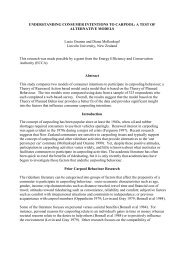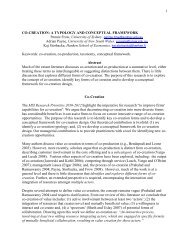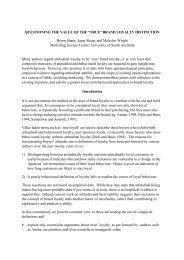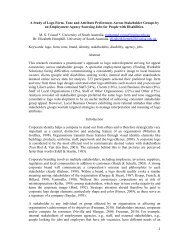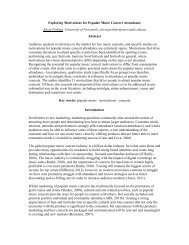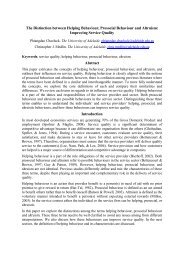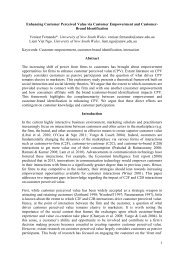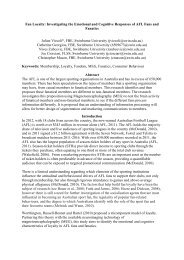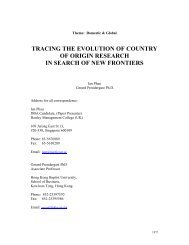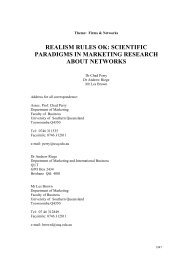1 Exploring a New Measure for Reactive Guilt Appeals ... - ANZMAC
1 Exploring a New Measure for Reactive Guilt Appeals ... - ANZMAC
1 Exploring a New Measure for Reactive Guilt Appeals ... - ANZMAC
Create successful ePaper yourself
Turn your PDF publications into a flip-book with our unique Google optimized e-Paper software.
items were also removed to optimise the scale. Finally we were left with nine items relating to<br />
reactive scale (α = .873) (KMO and Bartlett’s test = .874, Approx. Chi-Square = 997.425, Df =<br />
36, Sig. = .000).<br />
Study Two<br />
The purpose of this study was to further fine-tune the initial reactive guilt scale. Scholars have<br />
suggested using Confirmatory Factor Analysis (CFA) as a means of reducing the scale items to<br />
confirm the scale’s final <strong>for</strong>m. This study was designed to examine the unidimensionality of the<br />
scale items developed in Study One. If it is necessary the study also aims to further purify the<br />
scale items. To test <strong>for</strong> the scale’s unidimensionality, CFA analysis was conducted using AMOS<br />
15 software.<br />
A real broadcast ad from an unknown brand (Patek Philippe) lasting two minutes was used as the<br />
stimulus. It has been suggested that prior brand knowledge may have an impact on emotional<br />
response (Chattopadhyay and Basu 1990) thus a brand with limited knowledge was used <strong>for</strong> the<br />
study. The choice of the ad was tested using an expert panel consisting of six members rated the<br />
ad highly as evoking reactive guilt. The experts chose the advertisement from a pool of four<br />
broadcast advertisements. The advertisement shows the relationship between the father and the<br />
son, and how the father passed down his legacy by giving his watch to the son. The<br />
advertisement highlighted the fact that the son did not value the watch at the time and sold it off.<br />
However, when the son became a man and he himself became a father, he realises the value of<br />
his father’s watch. The advertisement showed the son having a strong emotional attachment with<br />
his father’s watch and felt reactive guilt <strong>for</strong> selling it. He searched and searched <strong>for</strong> his father’s<br />
watch and finally found it at an auction. Respondents were asked to position themselves as the<br />
son from the ad and how they will respond after seeing the ad. The respondents then recorded<br />
their reactions to the ad based on a number of scales on a self-administered survey.<br />
A survey instrument using the nine items from Study One and demographics was developed. A<br />
total of one hundred and seventy seven useable responses were collected. CFA is commonly used<br />
as the second step in scale development (Pedhazur and Schmelkin 1991) because it is considered<br />
as a superior technique than EFA <strong>for</strong> assessing unidimensionality (O’Leary-Kelly and Vokurka<br />
1998).<br />
The results show a further reduction of the scale items. CFA refined the scales resulting in a total<br />
of 7 items <strong>for</strong> reactive guilt with acceptable measures (Hu and Bentler 1999) (Chi-square =<br />
20.085, Degrees of freedom = 14, Probability level = .127, AGFI = .940, RMSEA = .050, RMR =<br />
.077, α = .891).<br />
4




